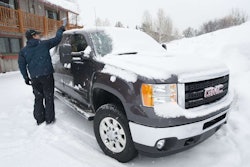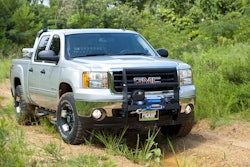Tips and tricks to eke a few more mpg from your pickups
By Bruce W. Smith
 It’s painful rolling away from the fuel pump knowing it just cost $120 to fill the fuel tank of the pickup you are driving.
It’s painful rolling away from the fuel pump knowing it just cost $120 to fill the fuel tank of the pickup you are driving.
Sure, those costs are passed on to your customers or municipality. But it would still be nice to trim such operating costs by 5 or 10 percent, helping bolster the annual corporate bottom line.
That’s why the majority of those in the construction and landscaping trades are either consciously or subconsciously trying to find ways to make their pickups more fuel-efficient in the work environment.
DRIVING TO BETTER MPG
If this is one of your goals, there are numerous approaches to bettering fuel economy. It begins with the driver.
It’s no secret fuel mileage drops exponentially as vehicle speed increases. The faster you drive, the more fuel it takes to push the truck through the air.
“Speed, acceleration, loading and maintenance all impact fuel economy more than final-drive ratio,” says Roger Clark, senior manager for General Motors Integration and Fuel Economy Learning Vehicles Program (FELVP), which handles EPA testing of all GM trucks and SUVs.
“For example, driving 10mph faster on the highway can reduce fuel economy by up to 4mpg.”
Using cruise control on long interstate drives is better for fuel mileage than trying to keep a constant speed with your right foot, too. When you get into hill country and mountains, use your right foot to slowly and evenly modulate throttle to keep speeds constant.
City driving requires similar driver vigilance: Lift the throttle early when coming to stops, and roll into the throttle slowly when pulling away from stop signs and stoplights will improve fuel mileage.
 Tire pressures and tire size/type make a difference in overall fuel economy. Maintain and choose wisely to maximize mpg.
Tire pressures and tire size/type make a difference in overall fuel economy. Maintain and choose wisely to maximize mpg.
Planning your work route to lessen backtracking, or making unnecessary trips also reduces fuel costs. So does keeping unnecessary tools, cargo and gear out of the truck.
Run light, run lean is a good overall motto for better fuel economy.
MILEAGE BOOSTERS
Another way to maximize fuel economy is making sure the engine is tuned-up. Plugs, coils and injectors that are not working at their optimum rob pickups of fuel mileage. So do dirty air and fuel filters.
The older the pickup, the more a poorly tuned and maintained engine affects overall fuel economy. For example, an ’02 model is going to show the effects far more than an ’09.
Changing engine oil to a 5W instead of a 10W or 20W, or even a 0W-20 or 0W-40 can also bring incremental boosts to fuel economy.
MORE MPG IMPROVERS
Tires are also a contributor to fuel economy numbers. Under-inflated tires, even by as little as 5psi, knock a few tenths from mpg. So do heavier, taller tires because they require more throttle to accelerate and to keep that heavier rolling mass moving.
If those taller mud tires aren’t absolutely necessary for the job, change to less aggressive, lighter tires or even shorter diameter tires.
Oh, and keep that tailgate up; wind-tunnel and track tests show a tailgate in the open position creates more aerodynamic drag and hurts mpg.
Few pickup upgrades or accessories improve fuel economy more than a tonneau cover. A hard tonneau provides slightly better mpg gains than a soft cover – but both are far better than leaving the bed open if you do a lot of highway driving.
Tonneau covers have been proven through wind-tunnel testing to reduce aerodynamic drag, and real-world tests have shown mpg boosts of a half to one mile per gallon in full-size pickups running highway speeds.
Adding all of these little items up isn’t going to take away the pain felt at the pump. But if your drivers and mechanics take improving fuel economy seriously, don’t be surprised to see a 15- to 20-percent reduction in annual fuel costs.







